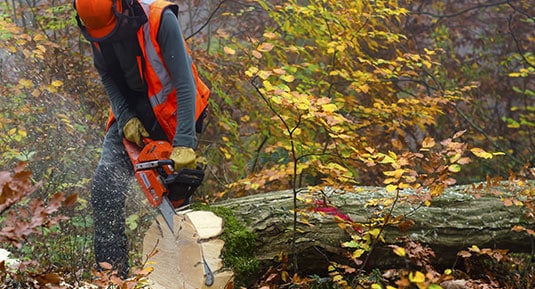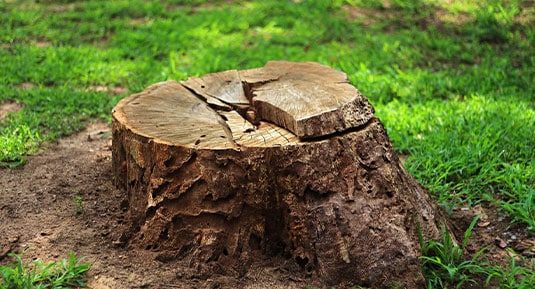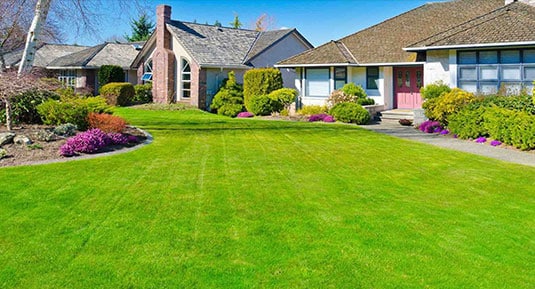The Palmetto Tree Service Difference
At Palmetto Tree Service, we believe that trees make the world a much more pleasant place to live. They provide us with refreshing shade, verdant beauty, cool shade, and emergency shelter. They add personality to our homes, raise our property values, and give us clean air to breathe. When your home is well-manicured, with healthy trees, everyone around benefits. That's why, as arborists, we are passionate about providing our customers with dependable Lowcountry tree care.
We believe that honest prices, state-of-the-art equipment, friendly arborists, and good old-fashioned hard work set us apart from our competition. With years of experience serving homeowners in South Carolina, you can rest easy knowing every member of our team is committed to:
- Conducting themselves in a professional manner
- Providing you with top-notch tree care services
- Arriving at your property on time and ready to work hard
- Providing you with reasonable tree care service rates
- Exceeding expectations
- Utilizing safe, time-tested techniques when trimming, pruning, or removing your trees and shrubs
- Friendly, helpful customer service
Our customers mean the world to us. When you hire our company for tree services in cityname, we take that responsibility seriously. No matter the size of your project, our team will always treat your home like it is our own. Plus, you won't ever have to worry about sneaky hidden fees or outrageous pricing. We believe every homeowner deserves access to affordable tree services!
Whether your home has overgrown trees that need trimming or you have unsightly stumps that require grinding, we're here to handle it all. Curious what kind of tree care we provide to homeowners in The Palmetto State?
Call Us
 843-345-0579
843-345-0579
Our Services
Services Area
Eco-Responsible Tree Removal in Sullivan's Island, SC
We have removed thousands of trees over the years. However, we never recommend tree removal if it's not warranted. Some South Carolina tree service companies tend to remove trees when they should be saved or simply pruned. Others go the opposite direction and never recommend tree removal.
Unlike other companies, our arborists make educated recommendations based on experience, your trees, and your needs. We make the right call for you - not for us. If disease, destruction of foundation, or other circumstances necessitate tree removal, rest assured we're recommending it for a reason.
Benefits of Tree Removal


Though we never recommend this service unless it's needed, tree removal is often the only way to protect your property and family. When done properly, removing trees from your yard can have numerous benefits.

Prevent Damage to Your Foundation
When the roots of a tree spread and grow, they often damage concrete structures, like your home's foundation or driveway. This unsightly, unsafe situation is preventable with careful tree removal.

More Yard Space
If you've got to remove trees, you might as well make use of the space. Removing trees from your yard frees up space for fun, useful additions to your home firepits and pools. Some examples that we've seen from clients include removing more free space to plant vegetables and flowers and even room to build a new basketball court.

Enhanced Views
Another benefit of tree removal is that you can create a better view for your home, both inside and out. If you have unhealthy trees blocking the view of your property, removing the tree could be a solution. On the other side of the coin, you might want the exterior view of your home to remain intact and unobstructed by trees.
Tree Trimming in Sullivan's Island, SC
Have you noticed your favorite tree growing strangely? Are your trees so overgrown that it's making your home look like vagrants live there? Are the trees around your property weighed down by dead, dangerous branches? If you answered yes to any of those scenarios, Palmetto Tree Service has a solution to your problem.
Most folks don't know that trees respond to their environment. When trees aren't cared for, they can cause unwanted problems for the homeowner. Issues like overgrowth aren't just ugly - it's a potential safety hazard for your home and family. To prevent these problems from plaguing your property, it's important to keep your trees pruned and trimmed.
Our pruning and trimming have been described as "artistry" by our customers and are performed by highly skilled tree climbers per the Society of Arboriculture standards. Trimming procedures such as view enhancement and crown raising boosts curb appeal and open up obscured views. Proper pruning can also help establish your tree's structural integrity, which helps keep them planted firmly even in South Carolina wind gusts.
Because every shrub and tree is different, we approach our tree trimming projects with a detailed plan of action. That plan starts with our team of professional tree trimmers visiting your home. Once we see what kind of trees we'll be pruning or trimming, we'll put together an actionable plan which we'll share with you. As tree care specialists, we always account for unique variables like your tree's species and where they're located in your yard.

Benefits of Tree Trimming


For some folks, tree trimming seems like a minor detail in the grand scheme of homeownership. It can be tedious, but keeping your trees trimmed and well-maintained is more important than you might think. Below are just a few of the many benefits of keeping your trees and shrubs trimmed:

Tree Health
Part of the Palmetto Tree Service pruning and trimming process includes the removal of damaged, broken, dead, and diseased branches. When ignored, these dead and dying branches grow harmful fungi that can decimate the trees around your home or business. Removing these branches can help keep your trees healthy. Tree trimming also allows the sun and air to reach your trees, further helping to maintain their health.

Safety
As proud residents of South Carolina, we know how scary lightning storms and hurricanes are. Strong winds from these natural disasters result in fallen branches and uprooted trees. South Carolina's storm season is a serious concern for homeowners, especially those with tree-lined driveways, rec areas, and walking paths. When you trust Palmetto Tree Service, you're actually storm-proofing your home. If you have low-hanging limbs near home, pruning provides more safety and overhead clearance. That way, you don't have a panic attack every time the skies open up.

Aesthetics
Nobody likes the looks of a dying, disheveled tree. Tree trimming improves the general appearance of your tree and makes your whole yard and home look better. Tree trimming also helps prevent branches from intertwining with one another.

Developmental Tree Trimming
Pruning younger trees is crucial for their health as they age. This vital tree service in Sullivan's Island keeps young trees appealing and helps promote optimal branch structure.
Types of Tree Trimming
Not all tree trimming services from Palmetto Tree are the same. Our experts specialize in many trimming services, so you get the right kind of trim for your needs. Our team understands that even the slightest mistake can permanently affect your yard and trees. That's why we approach every project with precision and expertise.
Crown Reduction: When your trees age without proper care, they can develop too many branches on their interior. Trees like this give great shade, but too much is not a good sign. That's where crown reduction trimming comes in. By reducing the density of your tree's crown, our tree care experts improve its growth rate and health. Crown density reduction also promotes a longer lifespan and a more beautiful appearance.

Storm Prep and Cleanup: Trimming and pruning procedures like removing dead wood and thinning crowns should be done before a major storm hits. Reducing branches and leaves lessens the force that wind gusts have and helps minimize the chances of trees falling. If a storm does damage your land, Palmetto Tree Service has the team and tools to help. Having recently worked Hurricanes Charlie, Ivan, Wilma, Katrina, Ike, Irene, Florence, Dorian, and even Sandy, Palmetto Tree Service has vast experience with twisted and fallen trees. We protect your property from further damage and safely remove lumber from damaged structures.
Other tree trimming services that Palmetto Tree Service offers include:
- Hazardous Tree Assessments
- Shrub Trimming
- Pruning
- Cabling
- Bracing
- Corrective Trimming
Contact Us
Free EstimateStump Grinding in Sullivan's Island, SC
For most property owners, removing a tree can seem like a major project. While that notion certainly isn't wrong, tree removal is more straightforward and often easier than trying to remove an unsightly stump from your yard. Have you ever wondered why you see so many yards with stumps dotted around the land? It's because they're tough to remove. That is why Palmetto Tree Service offers stump removal services in South Carolina.
Our skilled stump grinders bring a depth of knowledge and modern tools to every project we approach. Available for any tree removal project, our fast, efficient grinding machines ensure stumps are 6-8 inches below grade. That way, you can plant your favorite bushes and shrubs where your stump used to be.
Our stump grinding and removal efforts don't just make your yard look great. They also save you time, money, and can prevent injuries. There's a time and place for DIY yard work, but stump removal isn't one of them. Going the "DIY" route can take weeks, even if you work an hour or two every day. There's also the issue of operating heavy machinery on your own, which is dangerous and costly. For these reasons alone, it's best to trust professional stump grinders to remove your tree stumps safely.

Benefits of Stump Removal in Sullivan's Island, SC



Pest Prevention
Tree stumps are notorious for harboring harmful pests that can ruin your property. We're talking ants, termites, carpenter bees, and other wood borers. If you've noticed an uptick in pests around your home, call Palmetto Tree Service for a quote on our stump removal. You could be killing two birds with one stone.

Eliminate Unwanted Growth
When you leave a tree stump in your yard, there's a good chance you could experience unwanted tree growth. These new growths cause clusters of small trees to grow at the base of your stump. This isn't only unsightly - it can kill nearby plants because the more recent growths hoard water and nutrients to themselves.

Better Looking Yard
If you're a homeowner who loves beautiful landscaping, well-sculpted hedges, and a neat law, you will love our stump removal services. Not just for the weight off your chest but for your home's enhanced curb appeal and resale value. This point is extra pertinent if you're going to sell your home soon.

More Space
If your yard is small, even one stump can affect your usable space. If you spend a lot of time playing sports or just enjoying your yard space, stump removal is a huge help. After all, nobody wants to toss a football if there are old stumps you've got to avoid. With their complicated root systems, stumps also take up considerable space below ground. Stump removal gives your family the space needed to grow vegies, plant flowers, erect water features, and more.

Reduce Headaches
Is stump removal impossible for non-professionals? Sure, in theory. You could take spend hours researching the best ways to remove stumps. You could go to your hardware store, rent a powerful stump grinder, and risk your safety trying to run it without training. You could spend every minute of your free time grinding the stump down. Or, you could work with a trustworthy stump removal company with trained professionals, as you'll find at Palmetto Tree Service.
Your Premier Tree Service Company in South Carolina
With years of experience, it's no wonder why so many South Carolina natives choose Palmetto Tree Service over the competition. Clients love us because we exceed expectations with a smile - no if's, and's, or but's.
Our commitment to superior service isn't a gimmick; it's a year-round promise. When you choose Palmetto Tree, you'll benefit from:
- Professional advice and expertise
- Seasoned, friendly, hardworking tree care experts
- Efficient, effective tree care services
- Competitive pricing
Ready to get started? We're ready to help! Give us a call to learn more about our tree care services and to schedule your first appointment today.
 843-345-0579
843-345-0579
Free Consultation
Latest News in Sullivan's Island, SC
Overnight fire causes major damage to Obstinate Daughter restaurant. Repairs are underway.
Caitlin Bellhttps://www.postandcourier.com/news/obstinate-daughter-fire-close-sullivans-island-restaurant/article_ddd48a90-cdc8-11ef-9b62-af699901c440.html
SULLIVAN'S ISLAND — The loud, steady hum of a 5,000-watt generator pierced the air Jan. 8 as crews worked to clear the damage left in the wake of an overnight fire at The Obstinate Daughter restaurant.On the upper floor of a business complex, it sits atop a sweets and pastry shop on the first floor. The double-landing staircase leading to the restaurant entrance was saturated with black, ashy water when Post and Courier reporters visited the site.White-shuttered windows looking out to the gravel parking lot were thrown wi...
SULLIVAN'S ISLAND — The loud, steady hum of a 5,000-watt generator pierced the air Jan. 8 as crews worked to clear the damage left in the wake of an overnight fire at The Obstinate Daughter restaurant.
On the upper floor of a business complex, it sits atop a sweets and pastry shop on the first floor. The double-landing staircase leading to the restaurant entrance was saturated with black, ashy water when Post and Courier reporters visited the site.
White-shuttered windows looking out to the gravel parking lot were thrown wide open — to help air out the building from smoke residue, said Davin Wise, a ServiceMaster representative on scene checking out the damage.
Due to the extent of the damage, the restaurant at 2063 Middle St. will likely be closed for a while, owner Doug Godley told The Post and Courier.
Firefighters responded to the restaurant at around 3 a.m., Sullivan's Island Fire & Rescue Chief Anthony Stith said. The responding station is directly across the street.
Isle of Palms and Mount Pleasant firefighters were on site to assist, Stith said.
Godley attributed the start of the fire to the dish pit in the kitchen but did not elaborate on what ignited the blaze.
Godley said his team is assessing the damage and will use security camera footage to track the cause of ignition.
The restaurant has an effective fire detection sprinkler system that greatly helped subdue the blaze, he said. Three sprinkler heads in the dish area went off and drenched the entire restaurant in water.
The fire caused minimal damage, but the massive water and smoke cleanup will take the brunt of the recovery effort, Godley said.
Ordinarily, the restaurant's dining room is dry and bordered by light, sun-bleached wood paneling. Godley declined to share descriptions of current interior damage or provide photos, instead wishing the restaurant to be remembered by patrons as it was — and will be — upon reopening.
Passersby marveled at the scene as men carried tables and chairs from the restaurant down the entry staircase.
One woman walking a dog remarked that, though she lives just around the corner, she heard no commotion in the early morning hours.
Several on the scene expressed concern for the restaurant and employees.
Manager Marisa Florentino estimated repairs would take a few weeks. Employees will be "well taken care of" during the closure, she told The Post and Courier.
The restaurant, which opened in 2014, has a menu that changes seasonally and focuses on pizza, pasta, small plates and its raw bar.
With a name that's an ode to Sullivan’s Island’s history — specifically a victory by American soldiers over the British in 1776 — Food Editor Parker Milner says The Obstinate Daughter is relaxed enough for a casual catch-up with friends, but it’s not a place that plays it safe.
Chef Jacques Larson, who landed on the semifinalist list for a James Beard Award in the Best Chef: Southeast category in 2024, leads a talented kitchen, empowering those he works with to push beyond their comfort zone.
In the years since opening, Obstinate Daughter has amassed "lots of loyal guests who love the place," Godley said.
Godley is focused on reopening the restaurant as soon as possible, but won't before the site is restored completely.
"We've got to get everything back to our standards," Godley said. "We want it to be as great as it's always been."
This Exclusive Island With Beaches Like Florida Is South Carolina's Version Of Beverly Hills
Jason Dookeranhttps://www.thetravel.com/beverly-hills-of-south-carolina-island-with-beaches-like-florida/
South Carolina has no shortage of beautiful towns worth visiting, but this one is one of the state's best-kept secrets. Dolphins breach the crystal-clear waters as golf carts whisk past centuries-old live oaks. Picture a place where flip-flops meet fine dining, historic bunkers have been transformed into chic libraries, and every sunset feels like a private show.This slice of paradise isn't just another beach town – it...
South Carolina has no shortage of beautiful towns worth visiting, but this one is one of the state's best-kept secrets. Dolphins breach the crystal-clear waters as golf carts whisk past centuries-old live oaks. Picture a place where flip-flops meet fine dining, historic bunkers have been transformed into chic libraries, and every sunset feels like a private show.
This slice of paradise isn't just another beach town – it's where Southern charm and coastal luxury combine, creating an enclave that would make even California's elite raise their eyebrows in appreciation. These are just some of the awesome things a traveler can experience in South Carolina, and this exclusive island town offers all of them and more.
In South Carolina's version of Beverly Hills, there are no hotel towers blocking ocean views, no rowdy tourist crowds – just a few lucky residents who've discovered what might be the East Coast's best-kept secret. Welcome to Sullivan's Island, South Carolina's version of Beverly Hills, where multimillion-dollar homes peek through maritime forests and the Atlantic whispers tales of pirates and poets.
The "Mini Hawaii" Of South Carolina Is America's Most Underrated Small Town By The Sea
Thanks to the ambiance of Edisto Beach, South Carolina, you can experience a Hawaiian vibe without ever leaving the continental US.
Sullivan's Island, South Carolina, Is The Ultimate Coastal Sanctuary
Sullivan's Island won't be on the list of the most affordable islands to retire to in the US, but it has a depth of pedigree behind its opulence. Step onto Station 18 1/2, where waves lap against pristine shores and resident artists capture the morning light.
The same beaches that once inspired Edgar Allan Poe now showcase nature's daily performance – from pelicans diving for breakfast to kitesurfers dancing with the wind. Modern mansions hide behind century-old palms while longtime residents cruise to local haunts in golf carts, embodying the island's perfect blend of luxury and laid-back coastal living.
Sullivan's Island's beaches aren't just comparable to Florida's—some would contend they are better. While Florida may have more sunshine, Sullivan's Island is more secluded, allowing visitors to truly experience the coastline uniquely.
It's not a place where thousands of people show up on the beach, but it's ideal for those who want to enjoy the coastline in a more private setting or a quieter environment.
When travelers think of Beverly Hills, they think of fancy buildings and breathtaking views. Sullivan's Island has both, and it's one of the most exclusive zip codes in South Carolina. Not only is it exclusive, but also quite expensive.
Sullivan's Island remains one of the most expensive places in South Carolina, showing how similar it is to California's most opulent neighborhood.
| Local Transport | |
|---|---|
| Unique Rules | |
| Distance from Charleston |
Visit Fort Moultrie, The Historic Fort That Saved America
This particular historical site is one of the many good reasons to visit South Carolina. Fort Moultrie is a testament to American resilience, where palmetto logs once absorbed British cannonballs like sponges.
Today, visitors walk the same grounds where Colonel William Moultrie's troops secured a pivotal victory in 1776, helping birth a nation. The fort, transformed over three centuries of coastal defense, offers an extraordinary glimpse into military history, with each chamber and cannon telling tales of courage under fire.
Sullivan's Island Is A Foodie's Paradise Without Pretense
Sullivan's Island is another one of the least crowded spots in South Carolina worth visiting, and its culinary lineage is a good reason. Along Middle Street, South Carolina's version of Beverly Hills reveals its tastiest secrets.
Local chefs transform fresh-caught seafood into culinary masterpieces, while historic buildings house restaurants where reservations are as precious as beachfront property. The island's dining scene perfectly balances upscale offerings and casual coastal fare, where flip-flops are always welcome.
While there's a case for visiting Sullivan's Island at any time of the year, the best time for most travelers is in spring or summer. In spring, Sullivan's Island showcases its breathtaking flora and fauna, and its temperatures are ideal for exploring all over the island.
Summer offers the perfect setup for beach activities; the sun is ideal for a picnic on the beach or one of the island's meadows. Winter and fall are the low-season for the island, so visitors are not likely to see a lot of others in the area. They still offer some spectacular sights for dedicated travelers.
Edgar Allan Poe's Literary Legacy Meets Modern Luxury On Sullivan's Island
Edgar Allan Poe's spirit lives on in a former military bunker turned library. Streets named Raven and Gold Bug commemorate the famous author's time stationed at Fort Moultrie, while modern authors continue finding inspiration along these shores.
South Carolina's version of Beverly Hills proves that cultural richness and coastal luxury aren't mutually exclusive.
Sullivan's Island Is A Paradise That Defies Definition
Some might call Sullivan's Island South Carolina's version of Beverly Hills, but that comparison barely scratches the surface. There's more to this gorgeous spot than the pristine coastline, the fancy houses, or the historical significance.
It's one of the places in South Carolina that feels like home, no matter how long you visit. It's a place where luxury doesn't mean pretense, history lives in every grain of sand, and the simple pleasure of a sunrise still outshines any material wealth.
Move Over Charleston! This Idyllic South Carolina Island Has Cozy Beachside Cottages
Sam Searshttps://www.traveloffpath.com/move-over-charleston-this-idyllic-south-carolina-island-has-cozy-beachside-cottages/
Share The ArticleLast Updated 2 days agoSometimes, small towns leave a lasting mark bigger and better than the world's most sought-after destinations.Greeted with “how ya doin‘?” instead of “keep it movin” where you feel like just another face in the crowd, the South is teeming with hidden gems and quaint getaways that will have you coming back again and again.For example, when I visit Texas on occasion, I often find myself seeking out the small towns of Grapevine, G...
Share The Article
Last Updated 2 days ago
Sometimes, small towns leave a lasting mark bigger and better than the world's most sought-after destinations.
Greeted with “how ya doin‘?” instead of “keep it movin” where you feel like just another face in the crowd, the South is teeming with hidden gems and quaint getaways that will have you coming back again and again.
For example, when I visit Texas on occasion, I often find myself seeking out the small towns of Grapevine, Gruene, and Socorro, depending on where I am in the state, but certainly not Dallas or Austin.
Same goes for any state, but in this case, you may want to skip out on the tourist crowds of ever-so-trendy Charleston in favor of an idyllic, pint-sized island just 20 minutes away.
Practically a stone's throw from one of the South's most popular cities to indulge in rich history, epic eats, and timeless charm is Sullivan's Island, offering many of the same delights without hordes of visitors and overpriced menus.
This 3.5-mile-long barrier island is nestled along the Atlantic between numerous neighboring islands and, yes, Charleston.
Typically, you might hear of most vacationers making their way to Myrtle Beach, South Carolina's renowned coastal vacation spot lined with beachside resorts and a buzzing boardwalk, but Sullivan's Island has gotta be the state's best-kept secret.
Those seeking a tranquil beach getaway should look no further than Sullivan's Island, boasting a very walkable rustic downtown easy to peruse local shops, galleries, and bar-hop if you please.
While you may not see restaurants run by acclaimed chefs featured by the Food Network, among others, as you will in Charleston, you will discover homey southern comfort foods intermixed with “catch of the days” straight from the source.
Better yet, you won't have to spend a fraction of your paycheck on a cup of coffee since there's no Starbucks, a small example portraying the island's far less touristy vibes without the eyesores of chain restaurants ruining the townscape's character.
Originally named O'Sullivan Island after early settler Captain Florence O'Sullivan, the “O” has since been dropped, but many historic sites remain.
Having played a significant factor through multiple wars, including ground zero for the Battle of Sullivan's Island in 1776, tourists can visit preserved structures like Fort Moultrie, holding intriguing exhibits and sweeping views of the surrounding scenery.
Fort Moultrie also overlooks Fort Sumter, another significant site, but you'll need to detour back to Charleston to be able to reach the ladder via ferry.
While it may be tempting to grab a bite to eat in one of the country's most popular foodie cities, Sullivan's Island's food scene is nothing to sleep on, with exceptional seafood and mouthwatering barbecue that will have you asking for extra napkins.
Southern Living hyped up a few different spots, depending on your palate. If you're up to slurping down oysters, check out The Longboard's ‘Happy Hour'.
If you're the type to nibble every last bit of ribs, then Home Team BBQ is just for you. But, if it were me, I'd be feasting on a burger at Poe's Tavern, an establishment dedicated to famed poet Edgar Allan Poe, who was stationed on Sullivan's Island as a private in the Army in the 1800s.
Who woulda thunk it?
As delightful as Sullivan's Island's main strip and as fascinating and photo-worthy as the numerous historic sites may be, at its core, this island is a year-round beach destination.
Sullivan's Island Beach holds an impressive 4.7 Google Rating, largely in part due to so much open space, unlike, say, Myrtle Beach.
Station 18 Beach is also a tranquil spot, boasting white sand and calm waves, just like Sullivan's Island Beach.
One of the most underrated aspects, once you leave Charleston proper, is the ability to island-hop the region.
Next to Sullivan's Island, just past a small canal inlet, is Isle Palms Beach, well worth a day trip to see what it's all about with equally scenic beaches.
But where should you stay? You won't find name-brand hotels here. Sullivan's Island is all about cozy rentals.
Lining the shores from Sullivan's Island through next-door Isle of Palms are rows of beachside cottages.
You can book in a variety of ways, such as Airbnb, Booking.com, or by searching local agencies.
There's still plenty of occupancy to cap off winter with a relaxing getaway. I scoured the interwebs for the perfect seaside cottage, and this one is my favorite.
Costing only $410 for a weeklong stay, it's located directly next to the aforementioned Fort Moultrie and with immediate beach access and walkable to Sullivan's Island's Nature Trail.
Plus, who would say no to free wine at check-in?!
Sam, our Lead Writer & Journalist based in San Diego has visited 30 countries and written over 400 articles with a focus on sharing his own travel experiences and shining a light on lesser-known gems.
↓ Elevate Your Travel↓
Sign Up Now For Travel Off Path Premium! No ads, VIP Content, Personal Travel Concierge, Huge Savings, Daily Deals, Members Forum & More!
✈️Join Our Travel Off Path Community Forum: Where travelers unite, ask questions, share experiences and even find like-minded travel buddies!
SUBSCRIBE TO OUR LATEST POSTS
Enter your email address to subscribe to Travel Off Path's latest breaking travel news, straight to your inbox.
This article originally appeared on TravelOffPath.com
Opinions expressed here are the author’s alone, not those of any bank, credit card issuer, hotel, airline, or other entity. This content has not been reviewed, approved or otherwise endorsed by any of the entities included within the post.
Disclaimer:



